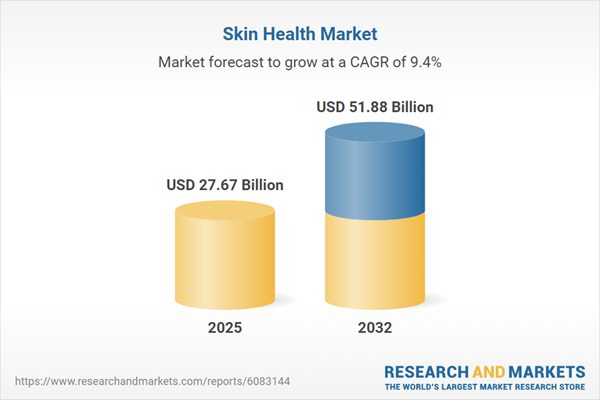Speak directly to the analyst to clarify any post sales queries you may have.
The skin health market is in a state of accelerated evolution, driven by scientific progress and changing buyer expectations. Senior decision-makers require unified, actionable insights to navigate complexity, mitigate risks, and maintain differentiation as new commercial and operational realities emerge.
Market Snapshot: Skin Health Market Size, Growth, and Forecast
The skin health market expanded from USD 25.34 billion in 2024 to USD 27.67 billion in 2025 and is anticipated to exhibit a CAGR of 9.36%, ultimately reaching USD 51.88 billion by 2032. This strong growth reflects a broadening emphasis on specialized product development, comprehensive wellness approaches, and market demand from both professionals and end consumers. Key trends include increased digital engagement, a diversified global supply network, and a decisive move towards innovative service delivery models that support brand competitiveness in a shifting environment.
Scope & Segmentation: Core Dynamics in the Skin Health Market
- Product Types: Cleansers are formulated for distinct skin types, available in cream, foaming, and gel options. Moisturizers now address hydration for various skin profiles, and advanced serums target anti-aging, brightening, and hydration needs. Specialized treatment solutions address concerns such as acne, pigmentation, and age-related skin changes.
- Distribution Channels: Products reach customers via beauty salons, professional centers, e-commerce (brand sites and online marketplaces), retail pharmacies, specialty beauty boutiques, and dermatology clinics.
- Applications: Formulations are developed for body, face, hands, and feet, each with targeted protocols and benefits tailored to diverse requirements.
- End Users: Solutions are increasingly adapted for children, men, and women, reflecting the rise of personalized regimens and changing consumer engagement patterns.
- Regions Covered: Analysis spans Americas, Europe, Middle East & Africa, and Asia-Pacific, accounting for regulatory variation, consumer behavior, and distribution strategy unique to each area.
- Key Technologies: The sector leverages advanced peptide engineering, microbiome modulation, nanoencapsulation, liposomal delivery, AI-enabled personalization, and blockchain traceability to foster innovation and operational effectiveness.
- Notable Companies: Major industry participants include L'Oréal S.A., Unilever PLC, The Procter & Gamble Company, Shiseido Company, The Estée Lauder Companies, Beiersdorf AG, Johnson & Johnson, Kao Corporation, Amorepacific Corporation, and Galderma S.A.
Key Takeaways for Senior Decision-Makers
- Scientific developments and transparency standards are restructuring innovation and delivery models, requiring brands to adapt strategies across R&D, marketing, and compliance.
- Personalized engagement, enabled by digital interaction, is strengthening omnichannel approaches and driving the need for robust analytics and adaptable customer experiences.
- Regional demand for solutions, such as those incorporating multifunctional features or botanical ingredients, highlights the necessity for responsive product portfolios and tailored marketing tactics.
- Supply chain resilience now hinges on agile sourcing methods and investment in digital traceability to manage disruptions, regulatory changes, and evolving procurement cycles.
- Collaboration with technology and biotech partners accelerates product validation and market expansion, reducing risks associated with narrow channel reliance.
- Sustainability commitments, including ethical sourcing and eco-friendly packaging, are now integral to regulatory compliance and stakeholder confidence in meeting ESG standards.
Impact of Tariffs and Supply Chain Resilience in the Skin Health Market
Recent tariff adjustments affecting core dermatological ingredients and packaging materials have added cost pressures and complexity to procurement. Industry leaders are responding by broadening their supplier base, investing in nearshoring within the Americas, and adopting digital traceability platforms. Enhanced scenario planning and contractual risk management are helping firms maintain steady supply and uphold quality standards during regulatory shifts.
Methodology & Data Sources
This market assessment utilizes a hybrid research approach, combining direct interviews with dermatology professionals and industry executives, consumer surveys, and structured secondary research from peer-reviewed publications, patents, and industry databases. Findings are triangulated and validated using a consistent taxonomy to assure reliability.
Why This Report Matters: Actionable Insights for Industry Leaders
- Provides an integrated, data-driven analysis of regional, consumer, and policy factors influencing the skin health market, giving stakeholders a robust planning foundation.
- Outlines tactical approaches for managing supply chain resilience, fostering innovation, and optimizing omnichannel presence to sustain growth in dynamic conditions.
Conclusion
Innovation, changing consumer dynamics, and a shifting regulatory environment are redefining the market landscape. Organizations that leverage real-time insights will build resilience, control risk, and access new opportunities in skin health.
Table of Contents
3. Executive Summary
4. Market Overview
7. Cumulative Impact of Artificial Intelligence 2025
Companies Mentioned
The companies profiled in this Skin Health market report include:- L'Oréal S.A.
- Unilever PLC
- The Procter & Gamble Company
- Shiseido Company, Limited
- The Estée Lauder Companies Inc.
- Beiersdorf AG
- Johnson & Johnson
- Kao Corporation
- Amorepacific Corporation
- Galderma S.A.
Table Information
| Report Attribute | Details |
|---|---|
| No. of Pages | 190 |
| Published | October 2025 |
| Forecast Period | 2025 - 2032 |
| Estimated Market Value ( USD | $ 27.67 Billion |
| Forecasted Market Value ( USD | $ 51.88 Billion |
| Compound Annual Growth Rate | 9.3% |
| Regions Covered | Global |
| No. of Companies Mentioned | 11 |









